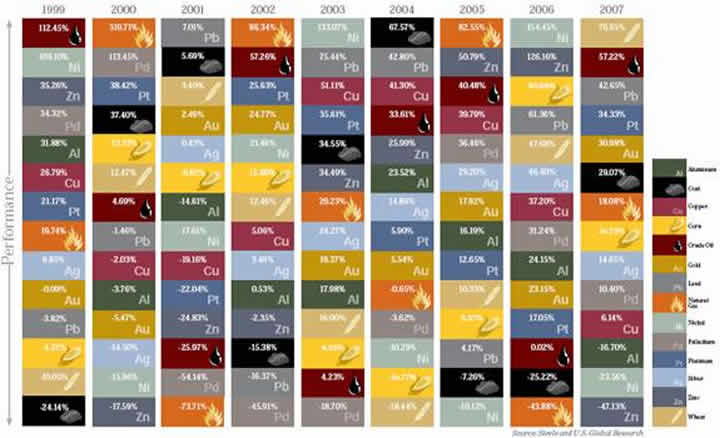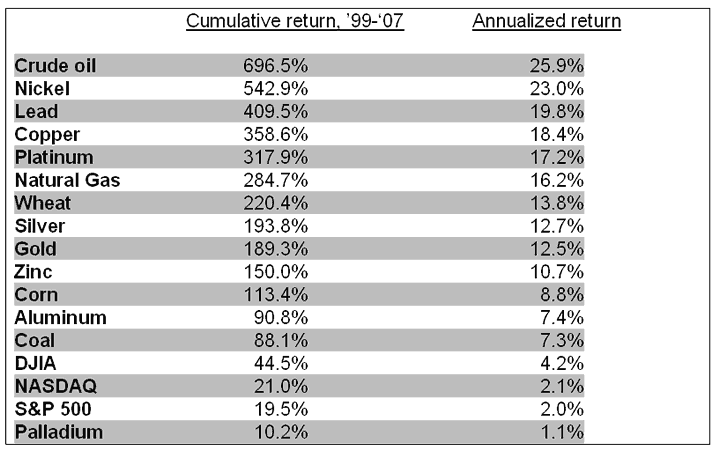Commodities Are Strong, But Which Ones Are the Strongest?
Commodities / Metals & Mining Jul 07, 2008 - 10:34 AM GMTBy: Frank_Holmes
 There's been plenty written about how well commodities have performed in recent years.
There's been plenty written about how well commodities have performed in recent years.
But do you know which of these commodities have done the best between 1999 and 2007? Do you know which ones have been the brightest stars so far in 2008?
Below is a “periodic table” that shows both the absolute and relative performance of 14 key commodities.

We put this table together to show how these commodities perform over the long term and how dramatically that performance can change from year to year.
So which of the 14 turned in the top overall performance?
The answer, by a wide margin, is crude oil. For anyone who drives a car, this should come as little surprise.
The price of crude went up nearly 700 percent between the beginning of 1999 and end of 2007. This works out to an annualized return of 26 percent over the nine years, although oil's returns ranged from a positive 112 percent in 1999 to a negative 26 percent two years later.
The No. 2 performer was nickel, which is primarily used in the production of stainless steel and other alloys. Nickel rose 543 percent between 1999 and 2007, with its best year coming in 2006 when it was up 154 percent.
Third-best on the list was lead at about 410 percent, followed by copper at nearly 360 percent. On the soft side, wheat and corn have tended to move together – in recent years, they've done quite well.
At the bottom of the heap was palladium, which rose only 10 percent over the nine years, or barely 1 percent per year on average. That doesn't mean it didn't have some good years – palladium was up 113 percent in 2000 and 36 percent in 2005 – but these were pretty much offset by a string of down years.
Coal and aluminum were among the worst performers among the commodities, but even their returns far exceeded those of the Dow Jones Industrial Average (up 44.5 percent), the Nasdaq Composite (up 21 percent) and the S&P 500 (up 19.5 percent) over the nine-year period.
Here's the complete list:

For the first six months of 2008, most of the talk has been about oil, but crude's 46 percent rise leaves it well down the performance list.
Coal, up 88 percent between 1999 and 2007, is 140 percent higher so far this year, natural gas has climbed nearly 80 percent and corn 59 percent. Palladium, the long-term laggard, is up 26 percent, while long-term standouts lead and nickel are down 30 percent and 16 percent, respectively.
Commodities have gained stature in the eyes of investors in recent years, and we're among those who believe that they should be considered a permanent asset class.
We've long suggested that investors consider an asset allocation approach advocated by prominent portfolio manager and author Roger Gibson in which investments are divided among four broad classes: domestic equities, international equities, fixed-income securities and hard assets (commodities, precious metals, real estate, etc.), and rebalanced annually. A long-term study by Gibson found that equal allocations among the four asset classes provided a good way of balancing risk and return.
And while commodity prices have been volatile, we believe that they will continue to offer excellent opportunities for investors. The strong growth trend in the BRIC countries and other large emerging markets are the result of voracious demand that is outstripping new supplies.
This trend is the key driver of commodities markets, not the “speculators” being demonized by election-year politicos on Capitol Hill. We would not be surprised by a short-term correction in resource prices, particularly for oil, but long-term we see prices going even higher.
By Frank Holmes, CEO , U.S. Global Investors
Frank Holmes is CEO and chief investment officer at U.S. Global Investors , a Texas-based investment adviser that specializes in natural resources, emerging markets and global infrastructure. The company's 13 mutual funds include the Global Resources Fund (PSPFX) , Gold and Precious Metals Fund (USERX) and Global MegaTrends Fund (MEGAX) .
More timely commentary from Frank Holmes is available in his investment blog, “Frank Talk”: www.usfunds.com/franktalk .
Please consider carefully the fund's investment objectives, risks, charges and expenses. For this and other important information, obtain a fund prospectus by visiting www.usfunds.com or by calling 1-800-US-FUNDS (1-800-873-8637). Read it carefully before investing. Distributed by U.S. Global Brokerage, Inc.
All opinions expressed and data provided are subject to change without notice. Some of these opinions may not be appropriate to every investor. Gold funds may be susceptible to adverse economic, political or regulatory developments due to concentrating in a single theme. The price of gold is subject to substantial price fluctuations over short periods of time and may be affected by unpredicted international monetary and political policies. We suggest investing no more than 5% to 10% of your portfolio in gold or gold stocks. The following securities mentioned in the article were held by one or more of U.S. Global Investors family of funds as of 12-31-07 : streetTRACKS Gold Trust.
Frank Holmes Archive |
© 2005-2022 http://www.MarketOracle.co.uk - The Market Oracle is a FREE Daily Financial Markets Analysis & Forecasting online publication.



